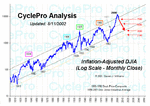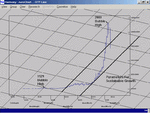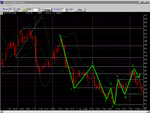🙂
Greetings fellow traders,
Thought I'd pop my head up above the parapet and declare that the Dow is now ripe to start its final descent into the abyss. Any takers ?
My assumption is based on the fact that the weekly chart is still in a downtrend with the 21 week ema still acting as resistance and 9000 still waiting to be overcome. We have 2 daily closes near or at the top of the bar and a nice naked high looking suspiciously like a bull trap or false breakout to me.
My trading style dictates that this is very nearly a perfect set up for a low risk short trade on a medium term basis. I shall be looking for the first signs of a breakdown in the hourly and 15 min charts with a wide stop somewhere just above the previous days intraday high for starters.
I would welcome your feedback on this idea folks, how it could be analysed better and how if it occurs we might maximise our gains ?
😉
Thanks
Greetings fellow traders,
Thought I'd pop my head up above the parapet and declare that the Dow is now ripe to start its final descent into the abyss. Any takers ?
My assumption is based on the fact that the weekly chart is still in a downtrend with the 21 week ema still acting as resistance and 9000 still waiting to be overcome. We have 2 daily closes near or at the top of the bar and a nice naked high looking suspiciously like a bull trap or false breakout to me.
My trading style dictates that this is very nearly a perfect set up for a low risk short trade on a medium term basis. I shall be looking for the first signs of a breakdown in the hourly and 15 min charts with a wide stop somewhere just above the previous days intraday high for starters.
I would welcome your feedback on this idea folks, how it could be analysed better and how if it occurs we might maximise our gains ?
😉
Thanks




